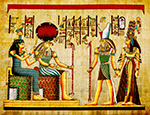The Snake Was Framed

You've probably seen or read at least one story on Cleopatra, who is among history's best known figures. But much mystery surrounds the Egyptian queen, including her death.
Though most historians believe she poisoned herself, another story blames a poisonous cobra for killing her and two attendants. To scrutinize the legend, Egyptologists and herpetologists gathered to discuss its likelihood.
They dispute the first detail which claims the cobra hid in a basket of figs. Cobras are usually five to six feet but can grow to eight feet in length, which is too big to hide in a basket.
The second problem is whether a snake would kill three people in quick succession. Highly unlikely.
Researchers in Asia, a region with high numbers of snake bites, have learned that cobra bites are often dry with no injection of venom because the snake often saves it for hunting and protection.
If Cleopatra was bitten by a cobra, she would have died a terrible death since the venom is a neurotoxin. Victims have trouble swallowing, seeing and breathing, and can vomit and have respiratory failure. Yet, the accounts say that the queen died a quick and painless death at the age of 39.
This bolsters historians' belief that she committed suicide with poison. Cleopatra died on August 12, 30 BC when Octavian, Julius Caesar's heir, fought his way into Alexandria. He had come to reclaim his throne from Cleopatra and her husband Marc Antony.
Antony killed himself when he heard Cleopatra had died, and she most likely poisoned herself inside her mausoleum as Octavian's troops entered her city. Though historians believe they were embalmed and buried, we don't know the location of their tomb.
So, it appears the snake was once again framed for something it didn't do, and no doubt this won't be the last time.